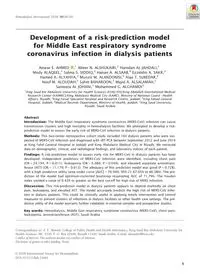
2018 Development of a risk-prediction model for Middle East respiratory syndrome coronavirus infection in dialysis patie PDF
Preview 2018 Development of a risk-prediction model for Middle East respiratory syndrome coronavirus infection in dialysis patie
Development of a risk-prediction model for Middle East respiratory syndrome coronavirus infection in dialysis patients Anwar E. AHMED ,1 Abeer N. ALSHUKAIRI,2 Hamdan AL-JAHDALI,1 Mody ALAQEEL,1 Salma S. SIDDIQ,3 Hanan A. ALSAAB,4 Ezzeldin A. SAKR,3 Hamed A. ALYAHYA,3 Munzir M. ALANDONISI,3 Alaa T. SUBEDAR,3 Nouf M. ALOUDAH,5 Salim BAHAROON,1 Majid A. ALSALAMAH,1 Sameera AL JOHANI,1 Mohammed G. ALGHAMDI3 1King Saud bin Abdulaziz University for Health Sciences (KSAU-HS)/King Abdullah International Medical Research Center (KAIMRC)/King Abdulaziz Medical City (KAMC), Ministry of National Guard - Health Affairs, Riyadh; 2King Faisal Specialist Hospital and Research Centre, Jeddah; 3King Fahad General Hospital, Jeddah; 4Medical Records Department, Ministry of Health, Jeddah; 5King Saud University, Riyadh, Saudi Arabia Abstract Introduction: The Middle East respiratory syndrome coronavirus (MERS-CoV) infection can cause transmission clusters and high mortality in hemodialysis facilities. We attempted to develop a risk- prediction model to assess the early risk of MERS-CoV infection in dialysis patients. Methods: This two-center retrospective cohort study included 104 dialysis patients who were sus- pected of MERS-CoV infection and diagnosed with rRT-PCR between September 2012 and June 2016 at King Fahd General Hospital in Jeddah and King Abdulaziz Medical City in Riyadh. We retrieved data on demographic, clinical, and radiological findings, and laboratory indices of each patient. Findings: A risk-prediction model to assess early risk for MERS-CoV in dialysis patients has been developed. Independent predictors of MERS-CoV infection were identified, including chest pain (OR 5 24.194; P 5 0.011), leukopenia (OR5 6.080; P 5 0.049), and elevated aspartate aminotrans- ferase (AST) (OR 5 11.179; P 5 0.013). The adequacy of this prediction model was good (P5 0.728), with a high predictive utility (area under curve [AUC] 5 76.99%; 95% CI: 67.05% to 86.38%). The pre- diction of the model had optimism-corrected bootstrap resampling AUC of 71.79%. The Youden index yielded a value of 0.439 or greater as the best cut-off for high risk of MERS infection. Discussion: This risk-prediction model in dialysis patients appears to depend markedly on chest pain, leukopenia, and elevated AST. The model accurately predicts the high risk of MERS-CoV infec- tion in dialysis patients. This could be clinically useful in applying timely intervention and control measures to prevent clusters of infections in dialysis facilities or other health care settings. The pre- dictive utility of the model warrants further validation in external samples and prospective studies. Key words: Hemodialysis, Middle East respiratory syndrome coronavirus (MERS-CoV), chest pain, leukopenia, aminotransferase (AST), Saudi Arabia Correspondence to: A. E. Ahmed, College of Public Health and Health Informatics, King Saud Bin Abdulaziz University for Health Sciences, MC 2350, P. O. Box 22490, Riyadh 11426, Saudi Arabia. E-mail:
